Analysis of Elastohydrodynamic Lubrication (EHL) Characteristics of Port Plate Pair of a Piston Pump
Abstract
1. Introduction
2. Establishment and Solution of the Port Plate Pair Mathematical Model
2.1. Model Calculation of the Port Plate Pair
2.2. Model Calculation of the EHL
2.3. Mesh Generation
2.4. Program Block Diagram
3. Oil Film Clearance and Pressure Distribution under the EHL Characteristics
3.1. Distribution of the Oil Film Thickness
3.2. Oil Film Pressure Distribution
3.3. Elastic Deformation Distribution of Oil Film
3.4. Oil Film EHL Distribution
3.5. Analysis of EHL Characteristics
- (1)
- Wedge oil film thickness varies with the inclination angle of the cylinder. It is thicker on the top and thinner on the bottom. Oil film pressure distribution in the sealing zone is nonlinear, resulting in dynamic changes in the oil film; oil film thickness in the low-pressure zone is thick. As the oil inlet and outlet of the valve plate are in a state of high pressure and low pressure, the cylinder block will be subjected to unloading torque, resulting in a slight inclination.
- (2)
- The elastic deformation is mainly concentrated in the anticlockwise transition of the high-pressure oil outlet. Therefore, the elastic deformation of the cylinder block/valve plate significantly influences the overall performance of fluid oil film.
4. Calculation of the EHL Characteristics of Two Pairs of Port Plate Pair
4.1. Influence of the Velocity on EHL Characteristics
4.2. Influence of Cylinder Block Inclination on the EHL Characteristics
4.3. Influence of Initial Oil Film Thickness on the EHL Characteristics
4.4. Influence of the Oil Film Viscosity on Elastohydrodynamic Characteristics
4.5. Influence of the Sealing Belt Width on EHL Characteristics
4.6. Comparison of the Operating Parameters on EHL Characteristics
- (1)
- The velocity of rotation: The tilt-gap dynamic pressure effect is evident when the cylinder block rotates at a high velocity. Dynamical pressure effects can only be formed when the two elements forming the seal gap form a relative motion and increase with increasing velocity.
- (2)
- The angle of inclination: The angle of inclination can change the oil film clearance. Dynamical pressure effects are evident as the tilt angle increases. The minimum film thickness is inversely proportional to the angle.
- (3)
- Initial oil film thickness: The initial oil film thickness between the cylinder and the valve plate can affect the oil film’s overall distribution and average stiffness. As the oil film becomes thinner, the pressure rises rapidly. The smaller the oil film gap, the larger the oil film squeeze, leading to more significant elastic deformation. The improper setting will fail to form a stable dynamic pressure effect, resulting in oil film rupture or leakage.
- (4)
- The lubricating oil viscosity: The dynamic pressure effect is evident as the viscosity increases. The greater the viscosity, the greater the shear force, higher pressure, and surface friction are formed, and the elastic deformation becomes more extensive and more profound.
- (5)
- Sealing belt width: The width of the valve plate’s inner and outer sealing belt can change the oil leakage speed, and the pressure gradient decreases along the width direction.
5. Lubricating Characteristics of the Port Plate Pair
5.1. Calculation of Mechanical Lubrication Characteristics
5.2. Calculation of Leakage Amount
6. Oil Film Lubrication Characteristics Experiment of Port Plate Pair
6.1. Experiment on Measuring the Oil Film Thickness of Port Plate Pair
6.2. Experiment of Friction Coefficient
6.3. Leakage and Torque Experiments
7. Conclusions
- (1)
- The pressure field can be changed by the transient deformation change caused by pressure. The simulation results show that transient deformation extrusion pressure affects the overall fluid film thickness. Furthermore, the wedge gap between the cylinder block and the valve plate produces mixed friction.
- (2)
- The simulation results show that the fluid film of design 2 (as shown in Table 2) has better stability, thinner fluid film, and more minor deformation, which ensures the whole film’s hydrodynamic lubrication and improves the sealing performance. For the cylinder body/valve plate interface performance to be stable and reliable, it is necessary to conduct the structural design and material properties.
- (3)
- The deformation due to fluid pressure significantly impacts the modeling leakage and the friction coefficient, especially when the deformation magnitude becomes comparable to the oil film clearance. Due to the reduction in static pressure bearing capacity, friction force, and friction coefficient caused by elastic deformation, a large amount of hydrodynamic pressure production is needed. The EHL effect is evident at the convergence of oil film.
- (4)
- Under high load and high speed, the rotation of the cylinder block affects the oil pressure field of port plate pairs. The local pressure peak affects the elastic deformation of the cylinder body/valve plate, which improves the EHL effect. In addition, because of the EHL effect, the back edge of the valve plate is lifted off the cylinder block, effectively maintaining the film thickness.
- (5)
- The oil film elastic deformation is related to the structural parameters of the piston pump, working conditions parameters of the piston pump and lubrication parameters of the oil film. However, further simulations and experimental verification are required to provide a theoretical basis for a high-speed and high-pressure piston pump. The calculated friction coefficient and offset load torque showed good qualitative and quantitative agreement with the measurements. A discrepancy between experimental and simulation results could have been caused by the restrictions imposed by the conditions used in the experiment since the pump can only change the speed, lubricating oil viscosity, and inlet pressure during the experiment.
Author Contributions
Funding
Institutional Review Board Statement
Informed Consent Statement
Data Availability Statement
Conflicts of Interest
Nomenclature
| Symbol | Name | Symbol | Name |
| h | Oil film thickness (m). | P | Working pressure (Pa). |
| Initial oil film thickness. | Standard atmospheric pressure | ||
| Oil film thickness without deformation. | η | Lubricating oil viscosity (Pa·s). | |
| v | Elastic deformation (μm). | Initial oil film viscosity. | |
| Elastic deformation displacement caused by pressure. | θ | Circumferential angle(°). | |
| . | δ | Deformation displacement. | |
| Ω | Solution domain. | Elastic deformation at node (k, l). | |
| . | |||
| The amount of deformation produced on the node k, l. | Deformation displacement of valve plate (μm). | ||
| Inner diameter (interior sealing belt). | Deformation displacement of cylinder block (μm). | ||
| Outer diameter (interior sealing belt). | ω | Velocity of rotation. | |
| Inner diameter (outer sealing belt). | φ | Tilt angle | |
| Outer diameter (outer sealing belt). | B | Sealing belt width (m). | |
| Comprehensive elastic modulus (Pa). | Poisson’s ratio for valve plate. | ||
| Elastic modulus of valve plate (Pa). | Poisson’s ratio for cylinder block. | ||
| Elastic modulus of cylinder block (Pa). | f | Friction coefficient. | |
| F | Carrying capacity (N). | Q | Leakage (L/min). |
| T | Offset load torque (N · m). | Friction force (N). |
References
- Ye, S.; Zhang, J.; Xu, B.; Hou, L.; Xiang, J.; Tang, H. A Theoretical Dynamic Model to Study the Vibration Response Characteristics of an Axial Piston Pump. Mech. Syst. Signal Process. 2021, 150, 107237. [Google Scholar] [CrossRef]
- Chen, Y.; Zhang, J.; Xu, B.; Chao, Q.; Liu, G. Multi-Objective Optimization of Micron-Scale Surface Textures for the Cylinder/Valve Plate Interface in Axial Piston Pumps. Tribol. Int. 2019, 138, 316–329. [Google Scholar] [CrossRef]
- Bae, J.-H.; Chung, W.-J.; Jang, J.-H.; Yoon, Y.-H.; Jeon, J.-Y. Study of Pressure and Flux Pulsation to Design Optimum Valve-Plate Notch and Pulsation-Variables Analysis of Swash-Plate-Type Piston Pump. J. Korean Soc. Manuf. Technol. Eng. 2015, 24, 244–250. [Google Scholar] [CrossRef][Green Version]
- Zloto, T.; Nagórka, A. Analysis of the Pressure Distribution of Oil Film in the Variable Height Gap between the Valve Plate and Cylinder Block in the Axial Piston Pump. TEKA Kom. Mot. Energ. Roln. OL PAN 2007, 7, 293–301. [Google Scholar]
- Zloto, T.; Sochacki, D.; Stryjewski, P. Analysis of Oil Leaks in a Variable-Height Gap between the Cylinder Block and the Valve Plate in a Piston Pump by Means of Author-Designed Software and CFD Fluent. Teka Kom. Motoryz. I Energetyki Rol. 2014, 14, 211–216. [Google Scholar]
- Zhu, Y.; Chen, X.; Zou, J.; Yang, H. A Study on the Influence of Surface Topography on the Low-Speed Tribological Performance of Port Plates in Axial Piston Pumps. Wear 2015, 338–339, 406–417. [Google Scholar] [CrossRef]
- Wang, S. Robust Design of Piston Assemblies in an Axial Piston Pump. Int. J. Fluid Power 2014, 15, 69–76. [Google Scholar] [CrossRef]
- Zloto, T. Simulation of the Hydrostatic Load of the Valve Plate-Cylinder Block System in an Axial Piston Pump. Procedia Eng. 2017, 177, 247–254. [Google Scholar] [CrossRef]
- Ivantysynova, M. A New Approach to the Design of Sealing and Bearing Gaps of Displacement Machines. Proc. JFPS Int. Symp. Fluid Power 1999, 1999, 45–50. [Google Scholar] [CrossRef][Green Version]
- Lijesh, K.P.; Amirthagadeswaran, K.S. Optimizing Interlayer and Coated Film Thickness for Minimum Stress Distribution under Elastohydrodynamic Lubrication Condition. In Proceedings of the Frontiers in Automobile and Mechanical Engineering-2010, Chennai, India, 25–27 November 2010; pp. 328–334. [Google Scholar]
- Chao, Q.; Zhang, J.; Xu, B.; Wang, Q. Discussion on the Reynolds Equation for the Slipper Bearing Modeling in Axial Piston Pumps. Tribol. Int. 2018, 118, 140–147. [Google Scholar] [CrossRef]
- Zhao, J.; Fu, Y.; Ma, J.; Fu, J.; Chao, Q.; Wang, Y. Review of Cylinder Block/Valve Plate Interface in Axial Piston Pumps: Theoretical Models, Experimental Investigations, and Optimal Design. Chin. J. Aeronaut. 2021, 34, 111–134. [Google Scholar] [CrossRef]
- Zecchi, M.; Ivantysynova, M. A Novel Fluid Structure Interaction Model for the Cylinder Block/Valve Plate Interface of Axial Piston Machines. In Proceedings of the 52nd National Conference on Fluid Power, Las Vegas, NV, USA, 23–25 March 2011; pp. 23–25. [Google Scholar]
- Achten, P.A.J.; Schellekens, M.P.A. Deformation Effects on the Load Carrying Capacity of the Barrel Bearing in Axial Piston Pumps and Motors. In Proceedings of the IMECE2006, Fluid Power Systems and Technology, Chicago, IL, USA, 5–10 November 2006; pp. 9–21. [Google Scholar]
- Manring, N.D.; Johnson, R.E.; Cherukuri, H.P. The Impact of Linear Deformations on Stationary Hydrostatic Thrust Bearings. J. Tribol. 2002, 124, 874–877. [Google Scholar] [CrossRef]
- Lin, X.; Jiang, S.; Zhang, C.; Liu, X. Thermohydrodynamic Analysis of High Speed Water-Lubricated Spiral Groove Thrust Bearing Considering Effects of Cavitation, Inertia and Turbulence. Tribol. Int. 2018, 119, 645–658. [Google Scholar] [CrossRef]
- Brown, S.R.; Hamilton, G.M.; Moore, S.L. Hydrodynamic Pressure under a Piston Ring. Nature 1975, 253, 341–342. [Google Scholar] [CrossRef]
- Johnson, K.L.; Roberts, A.D. Rheology of Oil Films at High Contact Pressures. Nature 1972, 240, 553–554. [Google Scholar] [CrossRef]
- Yamaguchi, A. Pressure Distribution on Valve Plate of Axial Plunger Pumps and Motors. Prod. Res. 1966, 18, 186–188. [Google Scholar]
- Yamaguchi, A.; Fujitani, Y.; Isoda, Y. Characteristics of Fluid Film between a Valve Plate and a Cylinder Block of Axial Piston Pumps and Motors. Hydraul. Pneum. 1984, 15, 64–72. [Google Scholar]
- Yamaguchi, A. Formation of a Fluid Film between a Valve Plate and a Cylinder Block of Piston Pumps and Motors: 2nd Report, A Valve Plate with Hydrostatic Pads: Heat Transfer, Combustion, Power, Thermophysical Properties. JSME Int. J. 1987, 30, 87–92. [Google Scholar] [CrossRef]
- Pan, H.; Sheng, J.; Lu, Y. Finite Difference Computation of Valve Plate Fluid Film Flows in Axial Piston Machines. Int. J. Mech. Sci. 1989, 31, 779–791. [Google Scholar] [CrossRef]
- Bergada, J.M.; Kumar, S.; Davies, D.L.; Watton, J. A Complete Analysis of Axial Piston Pump Leakage and Output Flow Ripples. Appl. Math. Model. 2012, 36, 1731–1751. [Google Scholar] [CrossRef]
- Huang, C. A New Approach to Predict the Load Carrying Ability of the Gap between Valve Plate and Cylinder Block. In Proceedings of the Bath Workshop of Power Transmission and Motion Control PTMC 2003, Bath, UK, 24 October 2003; pp. 225–239. [Google Scholar]
- Wang, B.; Zhou, H.; Yang, H. Real-Time Measurement on Lubrication Characteristic Parameters of Plane Port Pair in Axial Piston Pumps. Nongye Jixie Xuebao/Trans. Chin. Soc. Agric. Mach. 2009, 40, 170–213. [Google Scholar]
- Lin, S.; Hu, J. Tribo-Dynamic Model of Slipper Bearings. Appl. Math. Model. 2015, 39, 548–558. [Google Scholar] [CrossRef]
- Li, Y.; Ji, Z.; Yang, L.; Zhang, P.; Xu, B.; Zhang, J. Thermal-Fluid-Structure Coupling Analysis for Valve Plate Friction Pair of Axial Piston Pump in Electrohydrostatic Actuator (EHA) of Aircraft. Appl. Math. Model. 2017, 47, 839–858. [Google Scholar] [CrossRef]
- Pelosi, M.; Ivantysynova, M. A Novel Thermal Model for the Piston/Cylinder Interface of Piston Machines. In Proceedings of the DSCC2009, ASME 2009 Dynamic Systems and Control Conference, Hollywood, CA, USA, 12–14 October 2009; Volume 2, pp. 37–44. [Google Scholar]
- Schenk, A.; Ivantysynova, M. A Transient Thermoelastohydrodynamic Lubrication Model for the Slipper/Swashplate in Axial Piston Machines. J. Tribol. 2015, 137, 31701. [Google Scholar] [CrossRef]
- Shang, L.; Ivantysynova, M. Port and Case Flow Temperature Prediction for Axial Piston Machines. Int. J. Fluid Power 2015, 16, 35–51. [Google Scholar] [CrossRef]
- Tang, H.; Ren, Y.; Xiang, J. A Novel Model for Predicting Thermoelastohydrodynamic Lubrication Characteristics of Slipper Pair in Axial Piston Pump. Int. J. Mech. Sci. 2017, 124–125, 109–121. [Google Scholar] [CrossRef]
- Qian, P.; Pu, C.; Liu, L.; Li, X.; Zhang, B.; Gu, Z.; Meng, D. Development of a New High-Precision Friction Test Platform and Experimental Study of Friction Characteristics for Pneumatic Cylinders. Meas. Sci. Technol. 2022, 33, 65001. [Google Scholar] [CrossRef]
- Qian, P.; Pu, C.; Liu, L.; Lv, P.; Ruiz Páez, L.M. A Novel Pneumatic Actuator Based on High-Frequency Longitudinal Vibration Friction Reduction. Sens. Actuators A: Phys. 2022, 344, 113731. [Google Scholar] [CrossRef]
- Qian, P.; Pu, C.; He, D.; Lv, P.; Ruiz Páez, L.M. A Method to Improve the Motion Trajectory Tracking Accuracy of Pneumatic Servo System—By Exciting Longitudinal Resonance. J. Braz. Soc. Mech. Sci. Eng. 2022, 44, 376. [Google Scholar] [CrossRef]
- Edge, K.A.; Darling, J. The Pumping Dynamics of Swash Plate Piston Pumps. J. Dyn. Syst. Meas. Control 1989, 111, 307–312. [Google Scholar] [CrossRef]
- Brooks, D.W. Valve Plate for Axial Hydraulic Piston Pump or Motor. U.S. Patent 20,030,126,982, 1 January 2002. Available online: https://www.freepatentsonline.com/y2003/0126982.html (accessed on 10 July 2003).
- Nunomura, H. High-Pressure and Low-Pressure Selecting Valve and Swash-Plate Type Hydraulic Motor System. U.S. Patent 20,040,000,142, 27 June 2002. Available online: https://www.freepatentsonline.com/y2004/0000142.html (accessed on 1 January 2004).
- Wieczorek, U.; Ivantysynova, M. Computer Aided Optimization of Bearing and Sealing Gaps in Hydrostatic Machines—The Simulation Tool Caspar. Int. J. Fluid Power 2002, 3, 7–20. [Google Scholar] [CrossRef]
- Huang, P. Numerical Calculation of Elastohydrodynamic Lubrication: Methods and Programs; John Wiley & Sons: Hoboken, NJ, USA, 2015; ISBN 1-118-92098-8. [Google Scholar]
- Zhang, Y.; Zhang, H.; Zhao, Q.; Wang, X.; Zhang, T. Simulation of Pump Chamber Flow Field for Rotating-Sleeve Distributing-Flow System for Reciprocating Plunger Pump. Chin. Hydraul. Pneum. 2016, 11, 31–35. [Google Scholar]



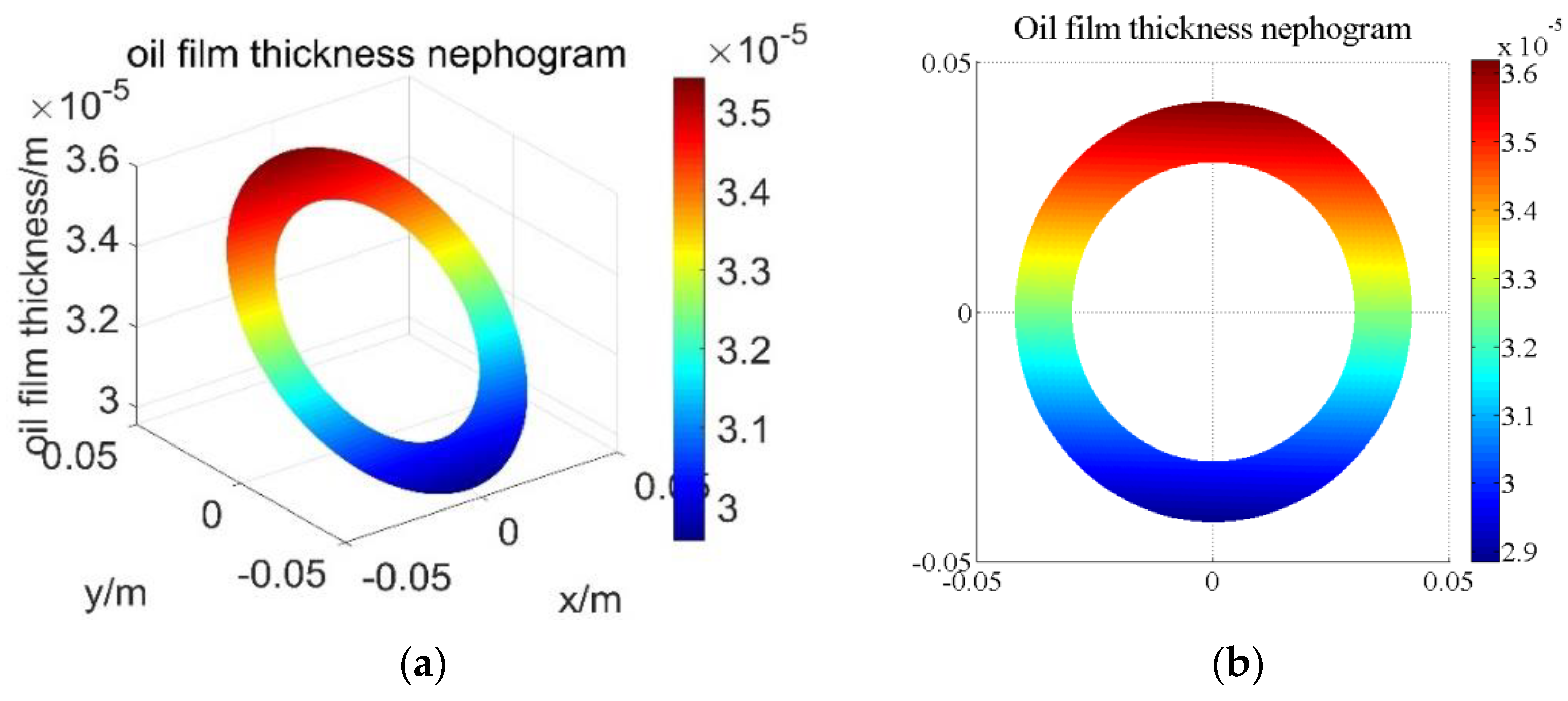

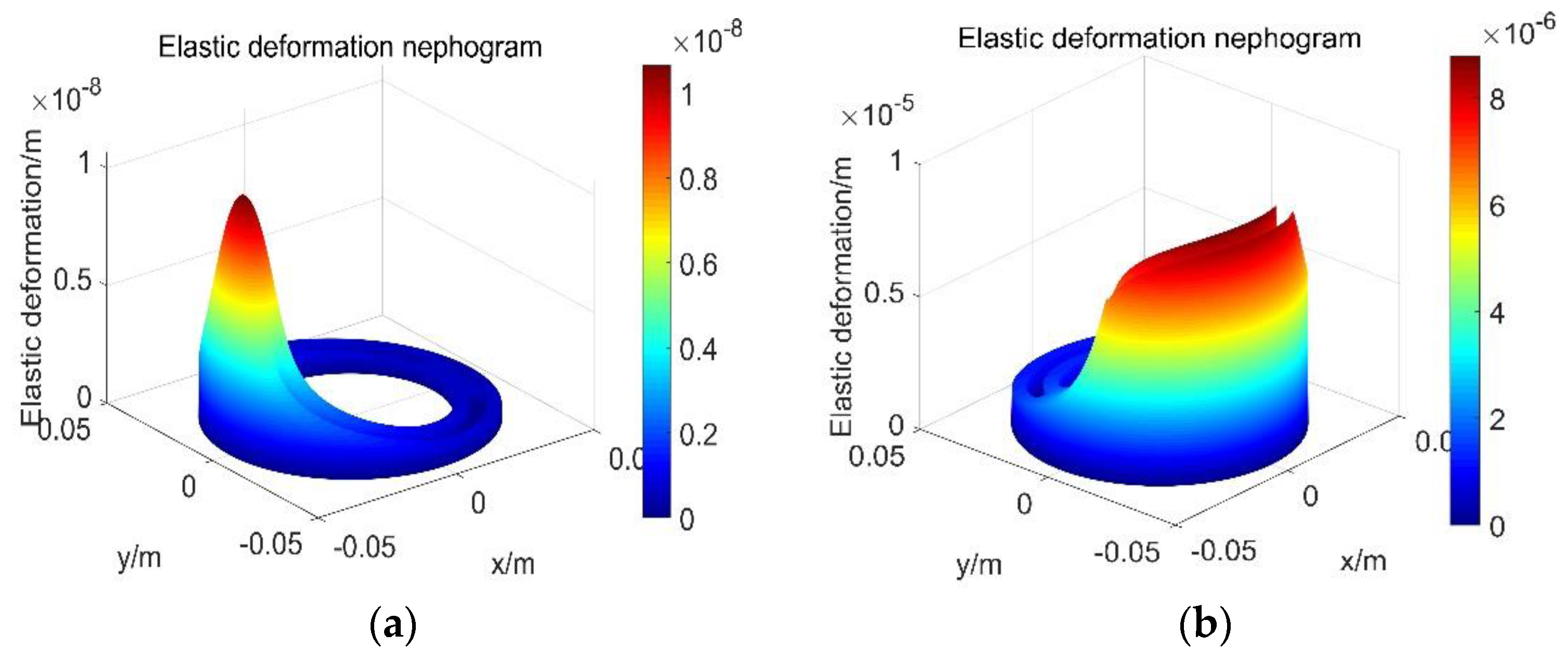


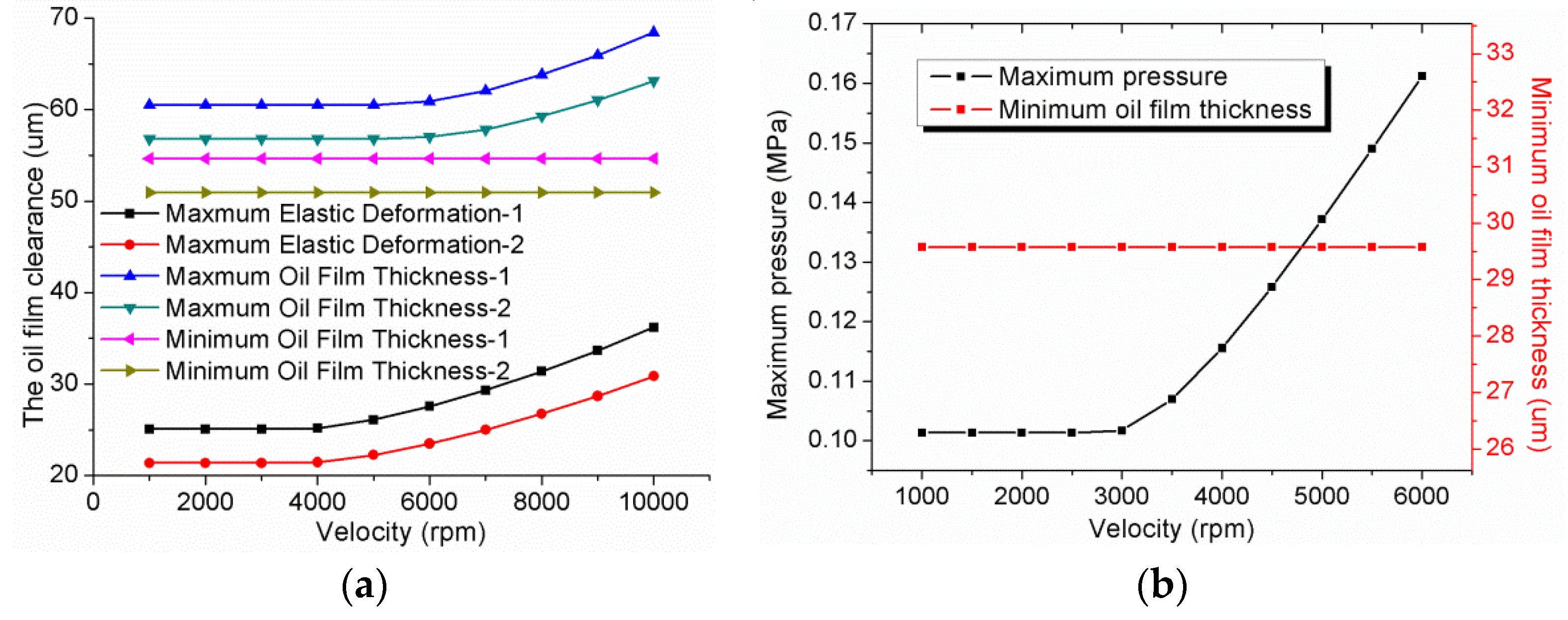
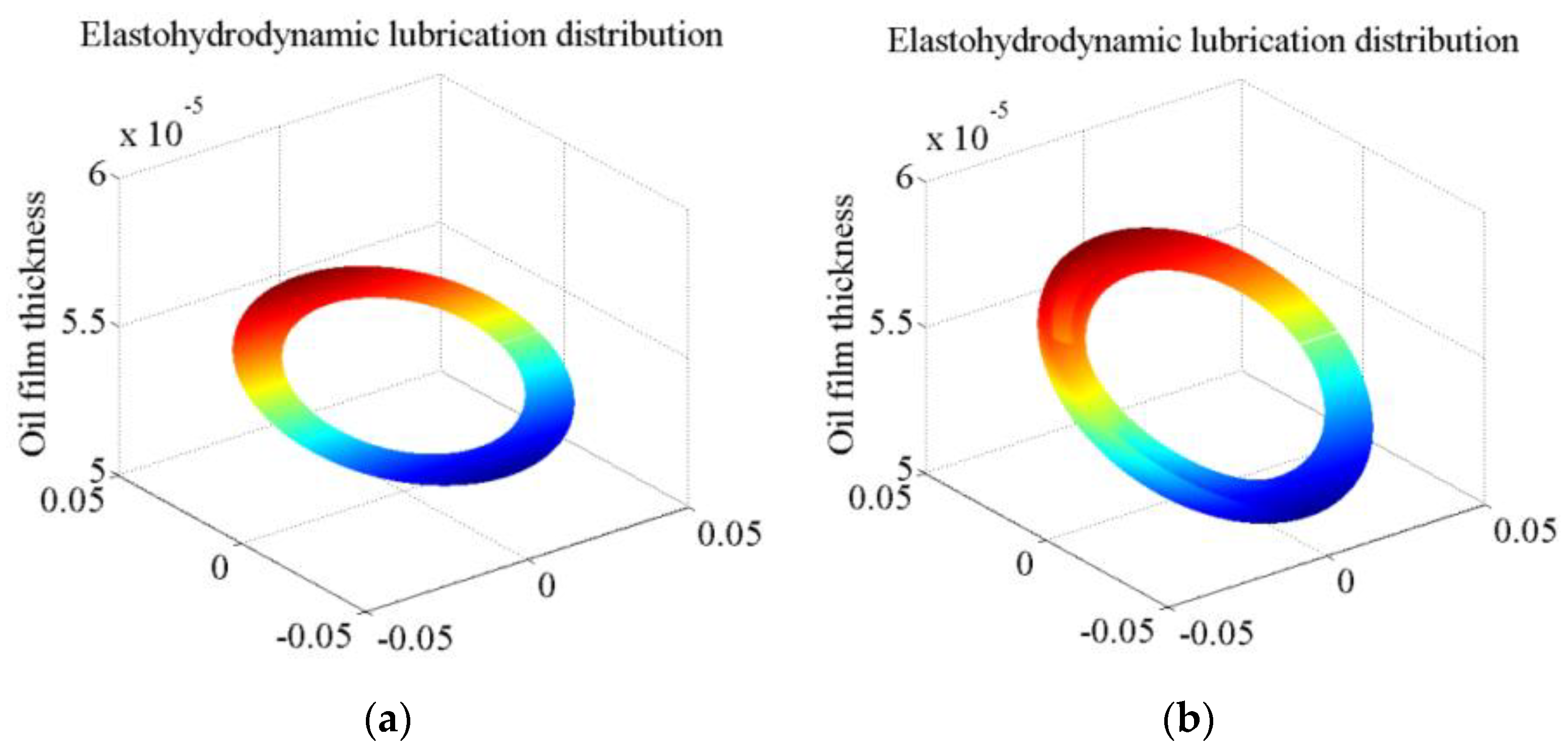
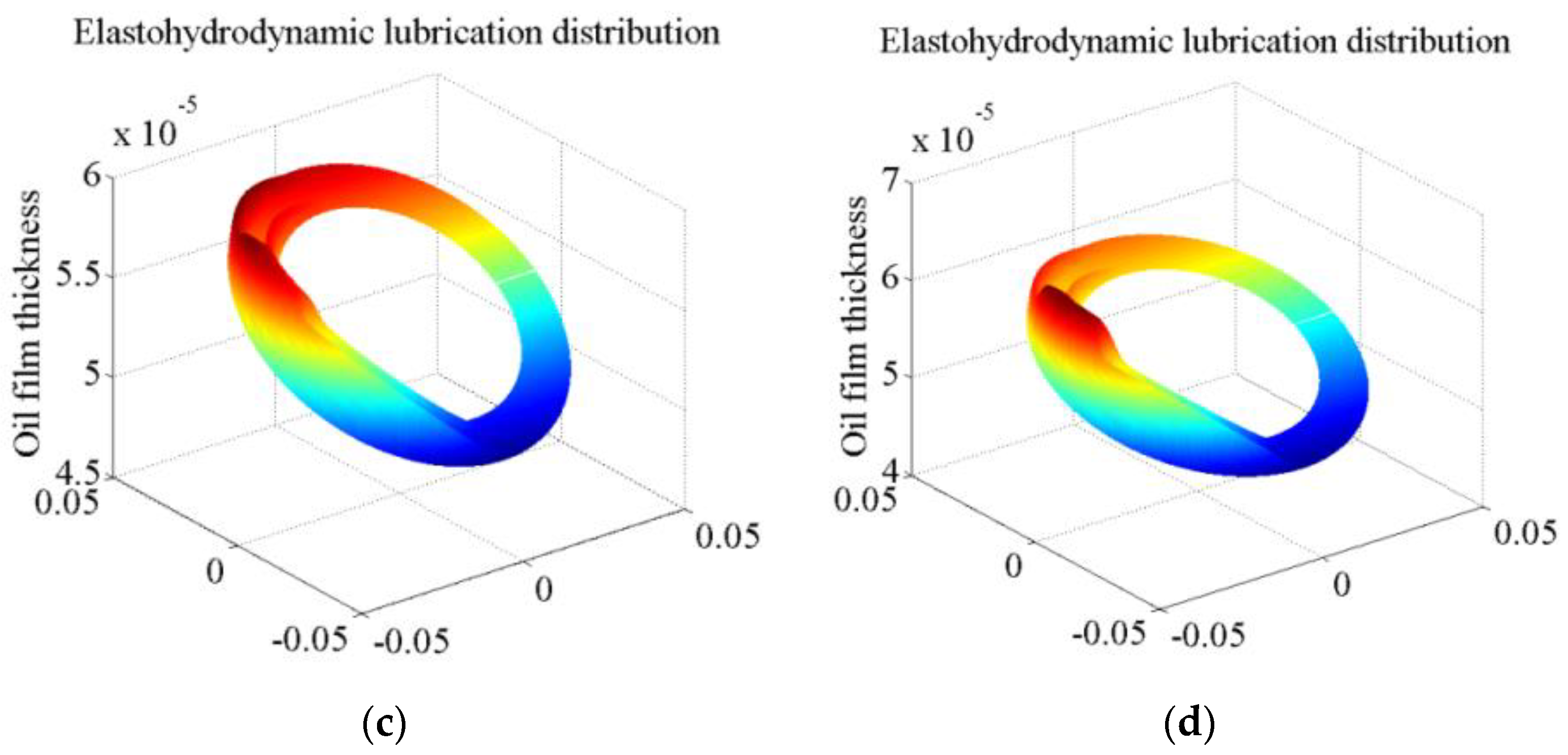
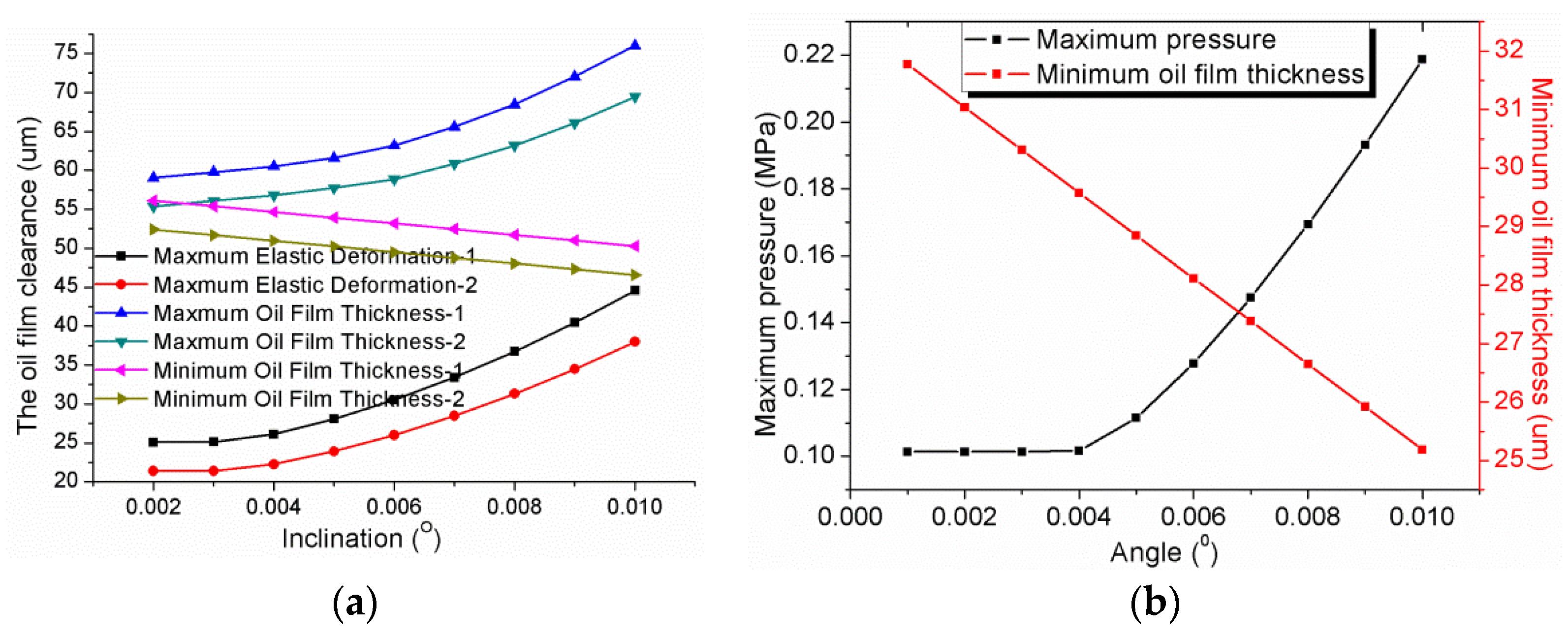
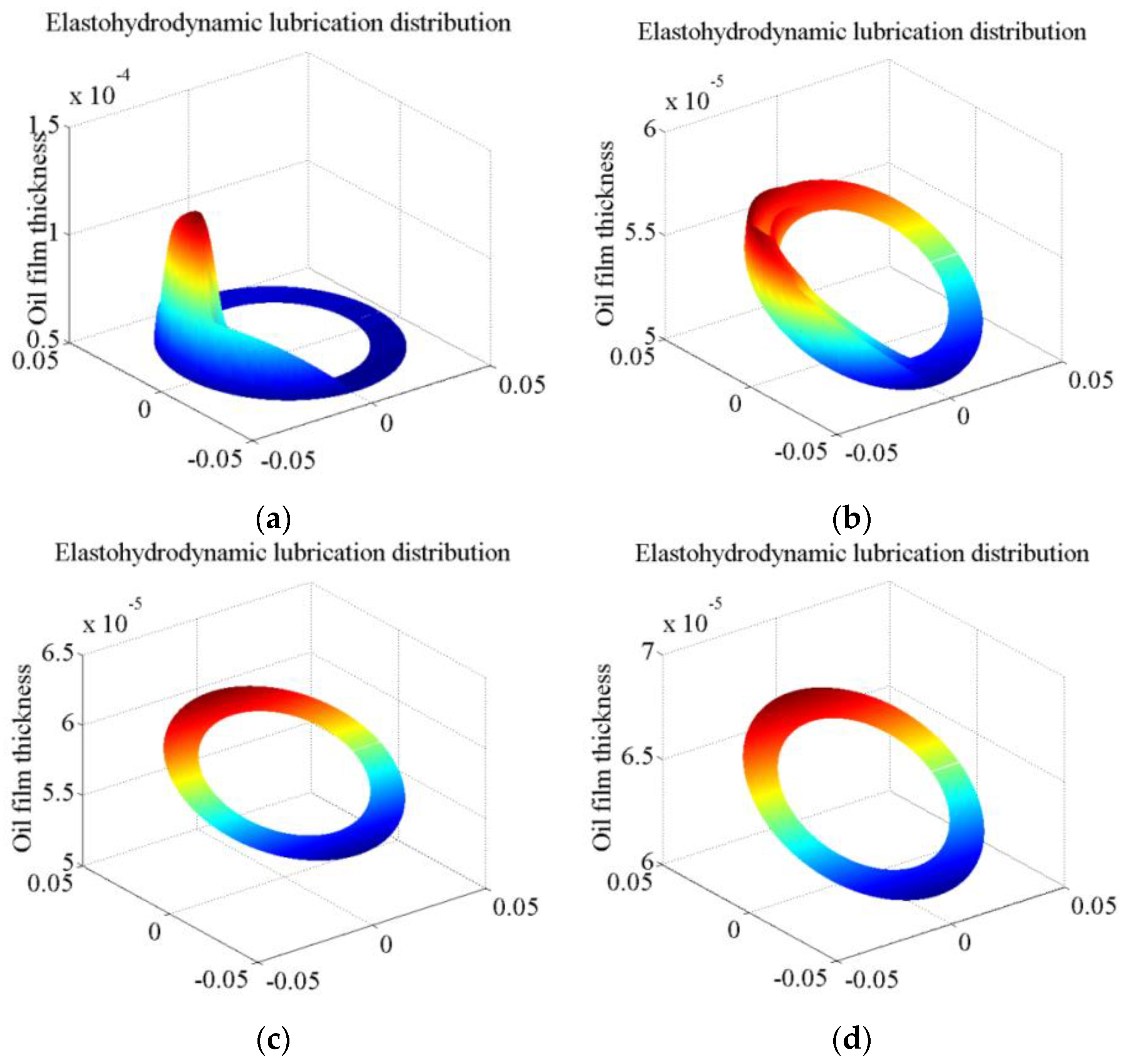
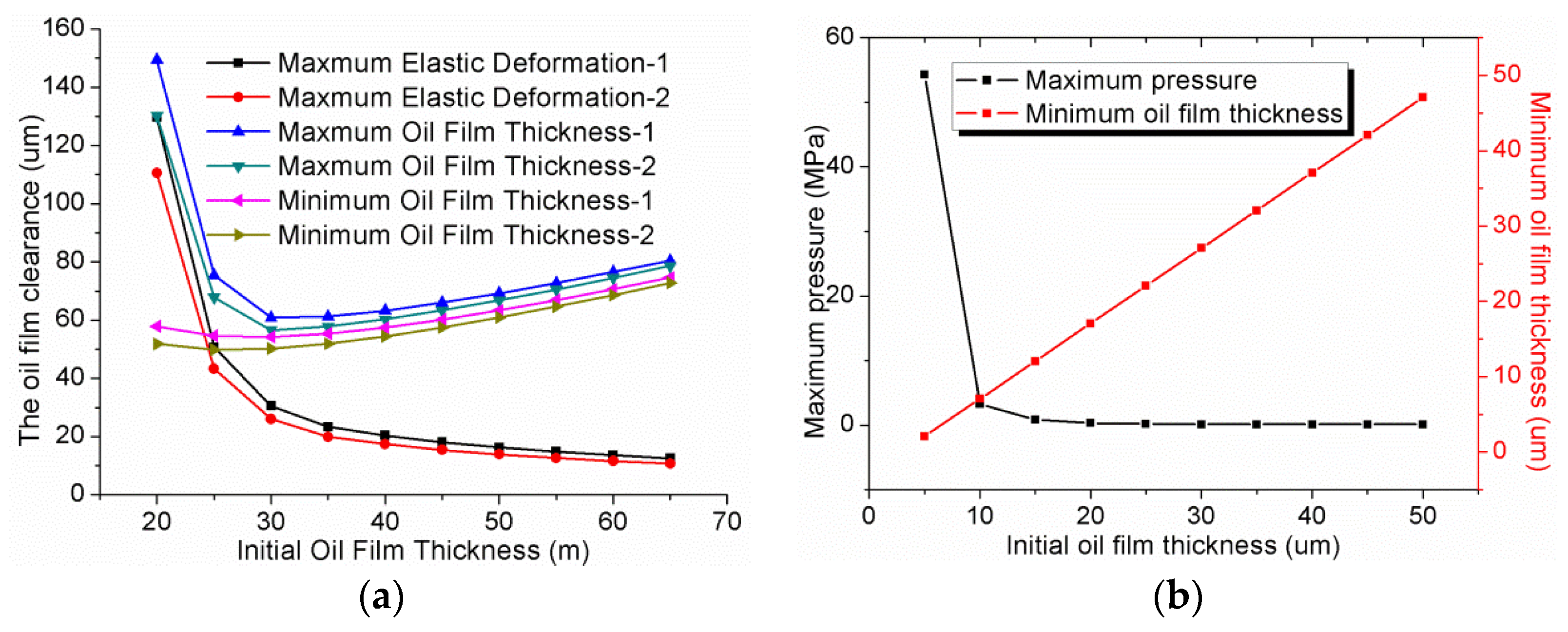

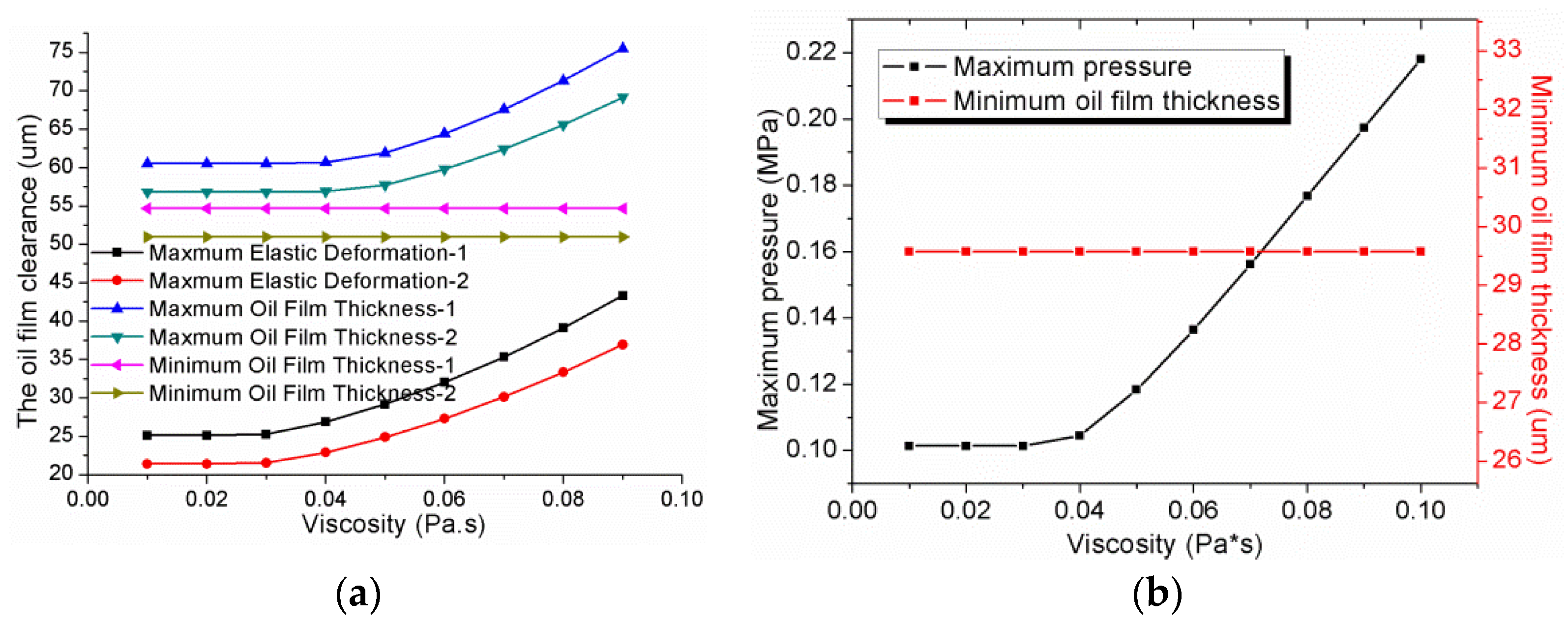

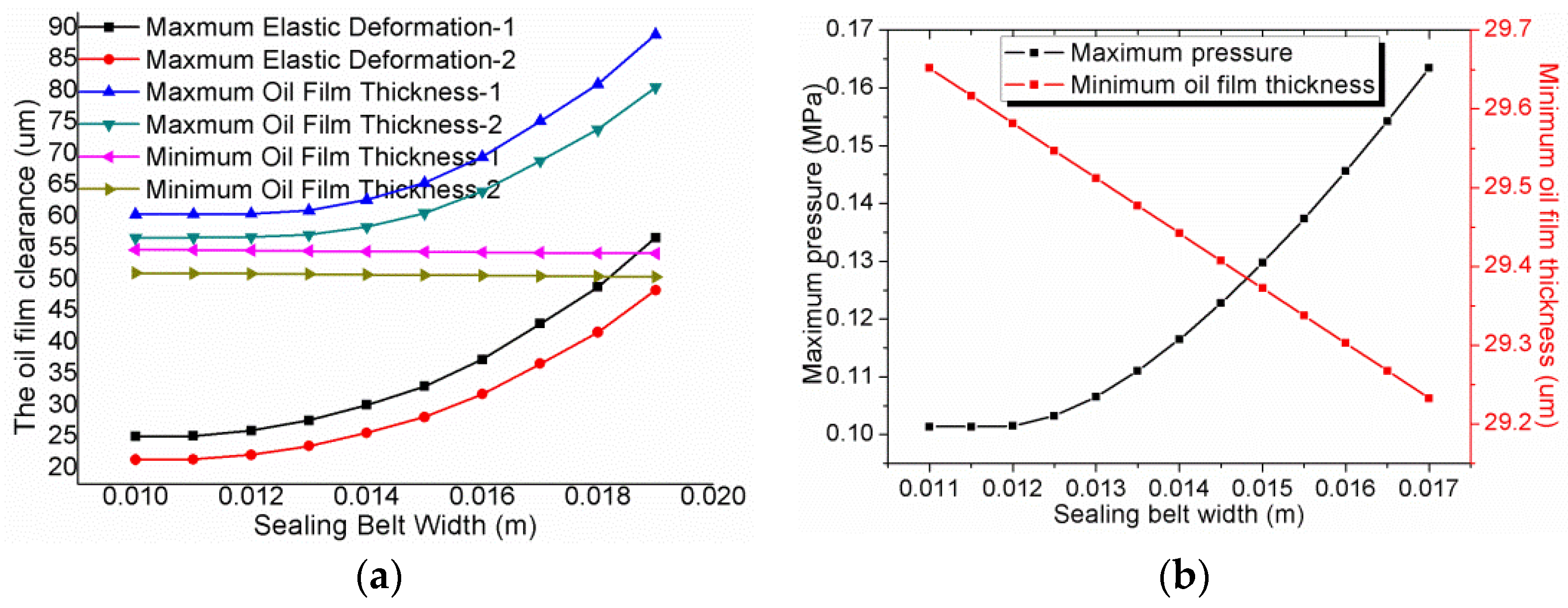
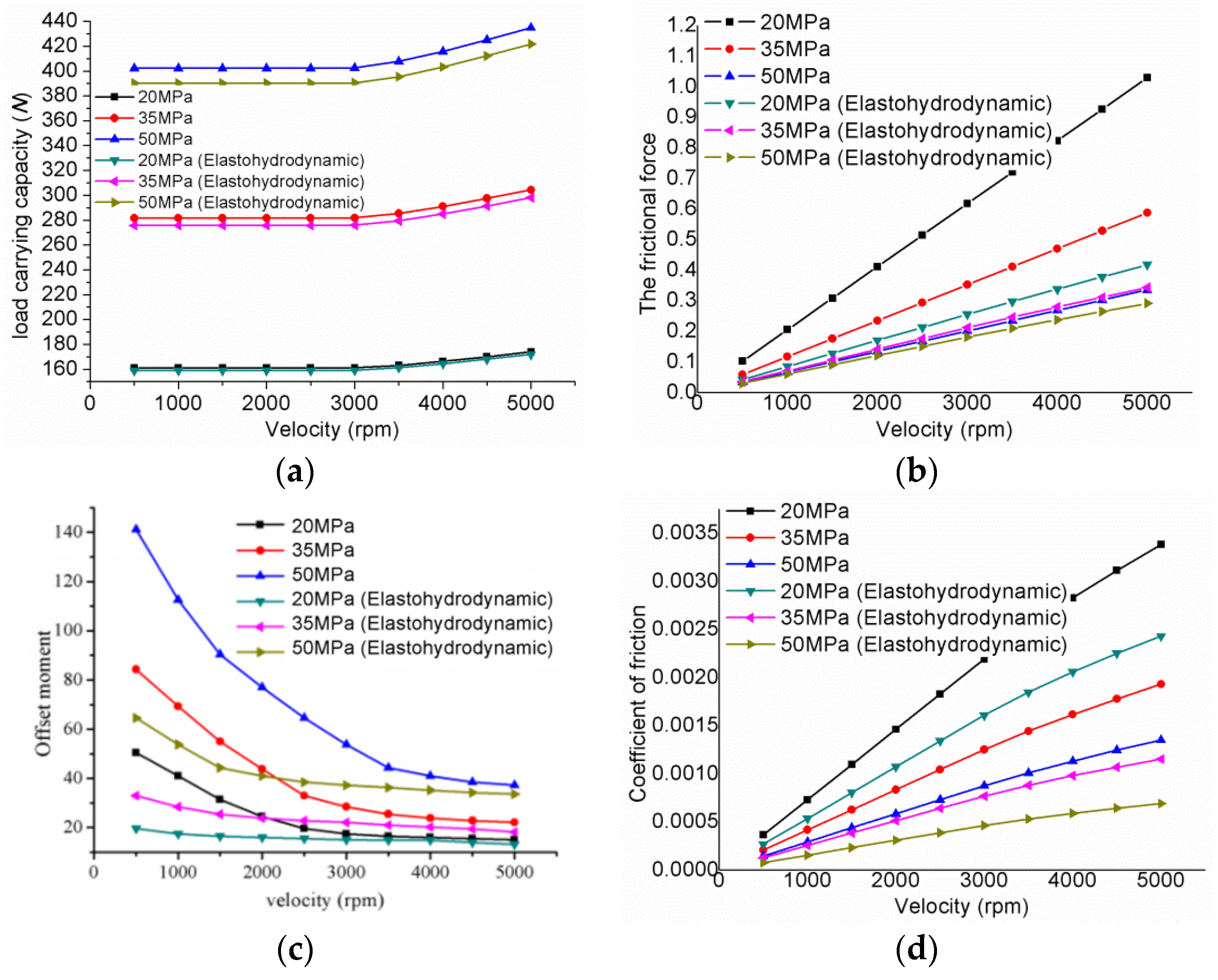

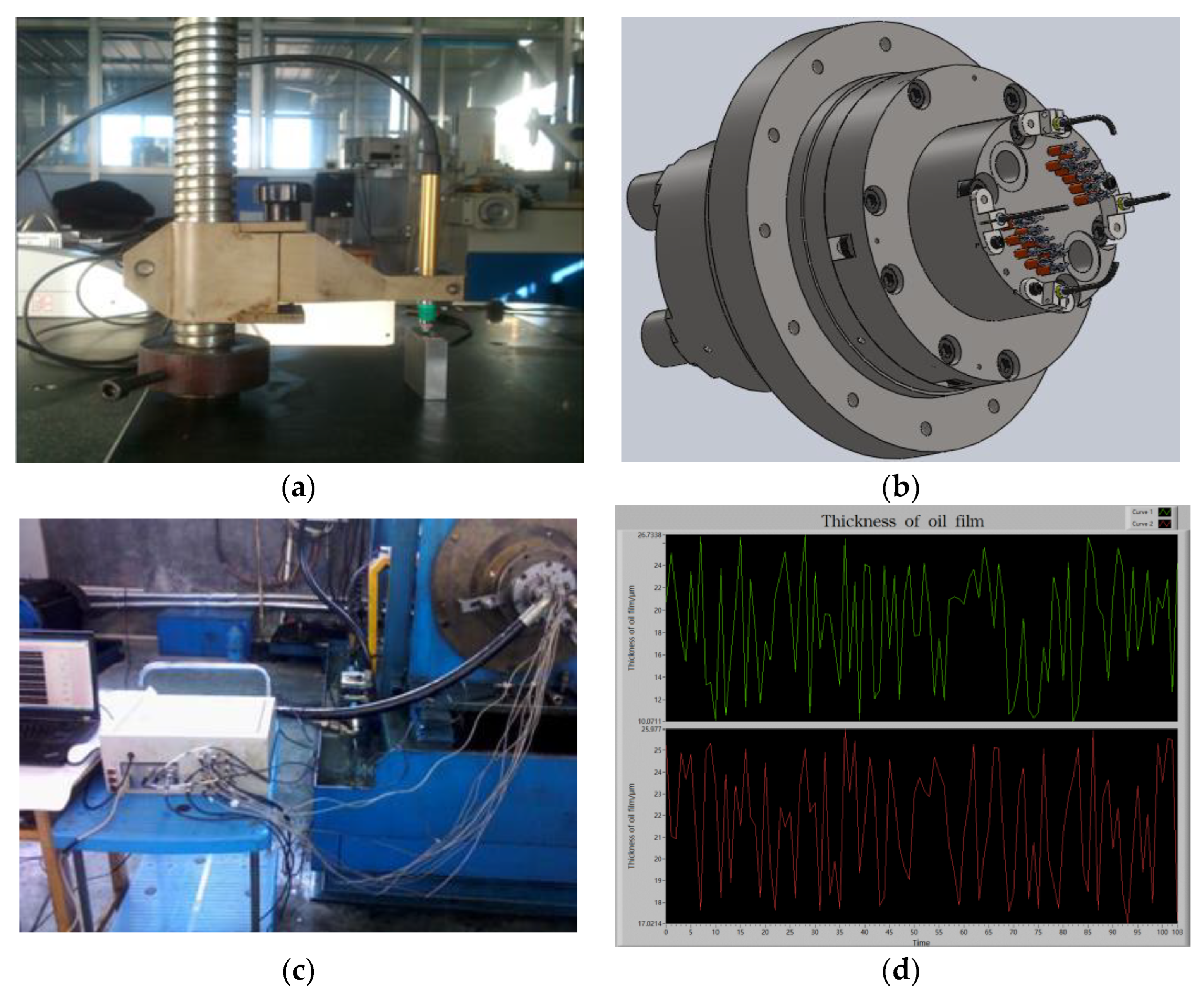


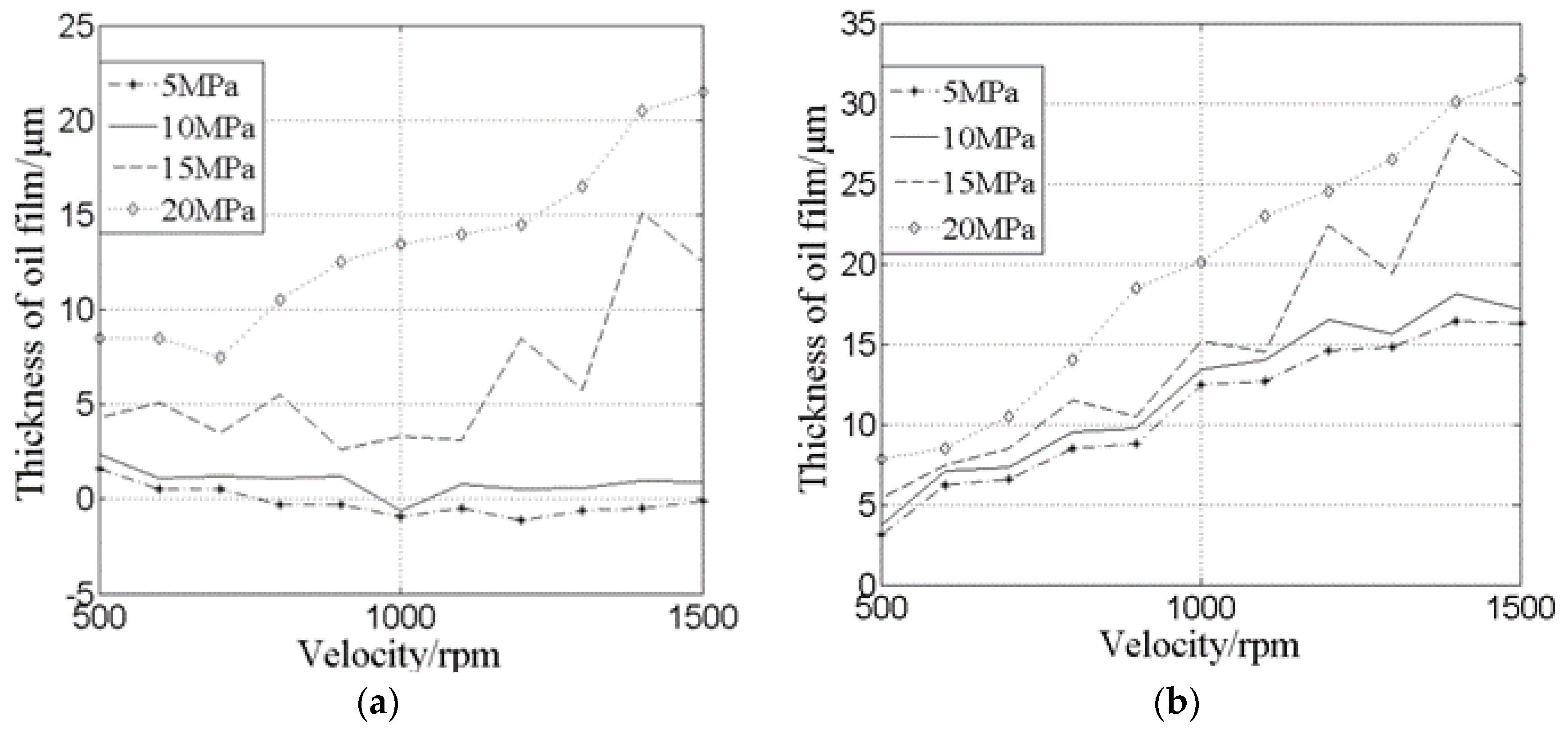






| Parameters | p | ω | φ | h0 | η0 |
|---|---|---|---|---|---|
| Numerical | 35 MPa | 3500 rpm | 0.004° | 32.5 μm | 0.0365 pa·s |
| Parameters | R1 | R2 | R3 | R4 | B |
| Numerical | 0.0298 m | 0.0339 m | 0.0379 m | 0.0419 m | 0.0121 m |
| Component | Materials | Poisson’s Ratio (V) | Elastic Modulus (E) |
|---|---|---|---|
| Cylinder block-1 | Nodular cast iron (QT 500) | 0.24 | 168 GPa |
| Cylinder block-2 | Manganese brass (HMn60-3-1-0.75) | 0.35 | 110 GPa |
| Valve plate-1 | Cast copper alloy (LBC3) | 0.3 | 103 GPa |
| Valve plate-2 | Nitriding steel (38CrMoAl) | 0.3 | 210 GPa |
Publisher’s Note: MDPI stays neutral with regard to jurisdictional claims in published maps and institutional affiliations. |
© 2022 by the authors. Licensee MDPI, Basel, Switzerland. This article is an open access article distributed under the terms and conditions of the Creative Commons Attribution (CC BY) license (https://creativecommons.org/licenses/by/4.0/).
Share and Cite
Wang, Z.; Han, B.; Sun, L. Analysis of Elastohydrodynamic Lubrication (EHL) Characteristics of Port Plate Pair of a Piston Pump. Machines 2022, 10, 1109. https://doi.org/10.3390/machines10121109
Wang Z, Han B, Sun L. Analysis of Elastohydrodynamic Lubrication (EHL) Characteristics of Port Plate Pair of a Piston Pump. Machines. 2022; 10(12):1109. https://doi.org/10.3390/machines10121109
Chicago/Turabian StyleWang, Zhaoqiang, Bo Han, and Lingtao Sun. 2022. "Analysis of Elastohydrodynamic Lubrication (EHL) Characteristics of Port Plate Pair of a Piston Pump" Machines 10, no. 12: 1109. https://doi.org/10.3390/machines10121109
APA StyleWang, Z., Han, B., & Sun, L. (2022). Analysis of Elastohydrodynamic Lubrication (EHL) Characteristics of Port Plate Pair of a Piston Pump. Machines, 10(12), 1109. https://doi.org/10.3390/machines10121109






